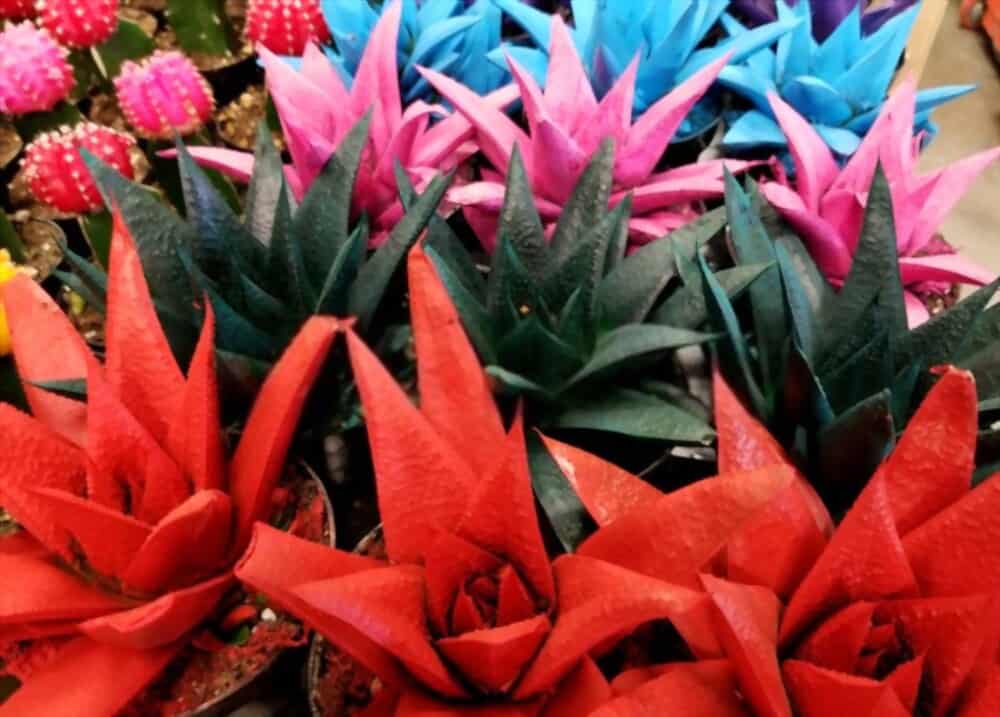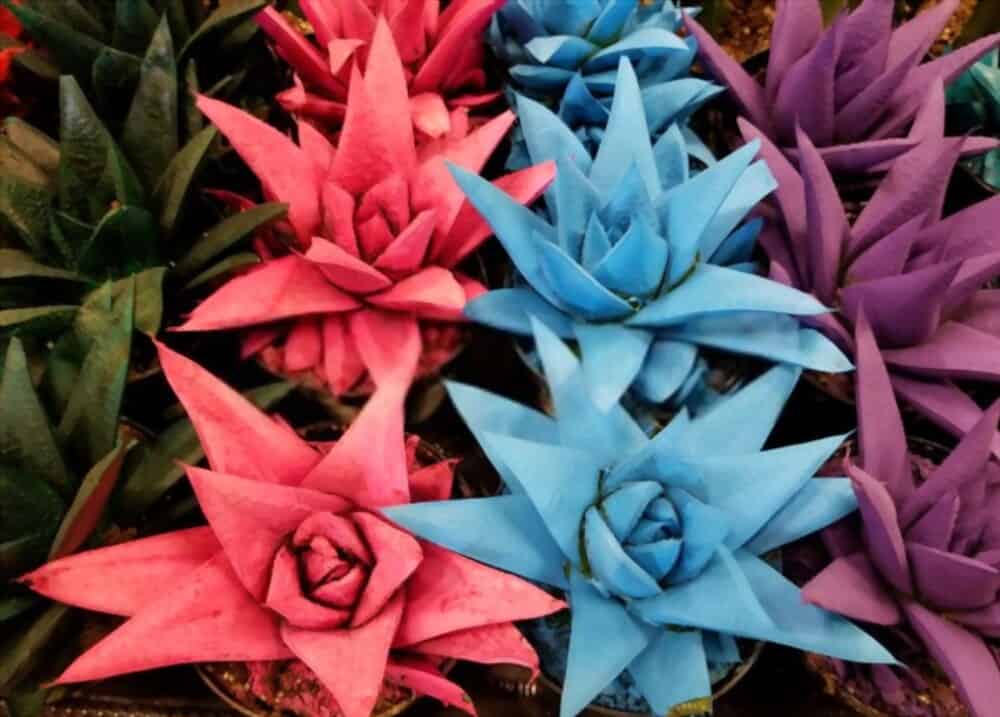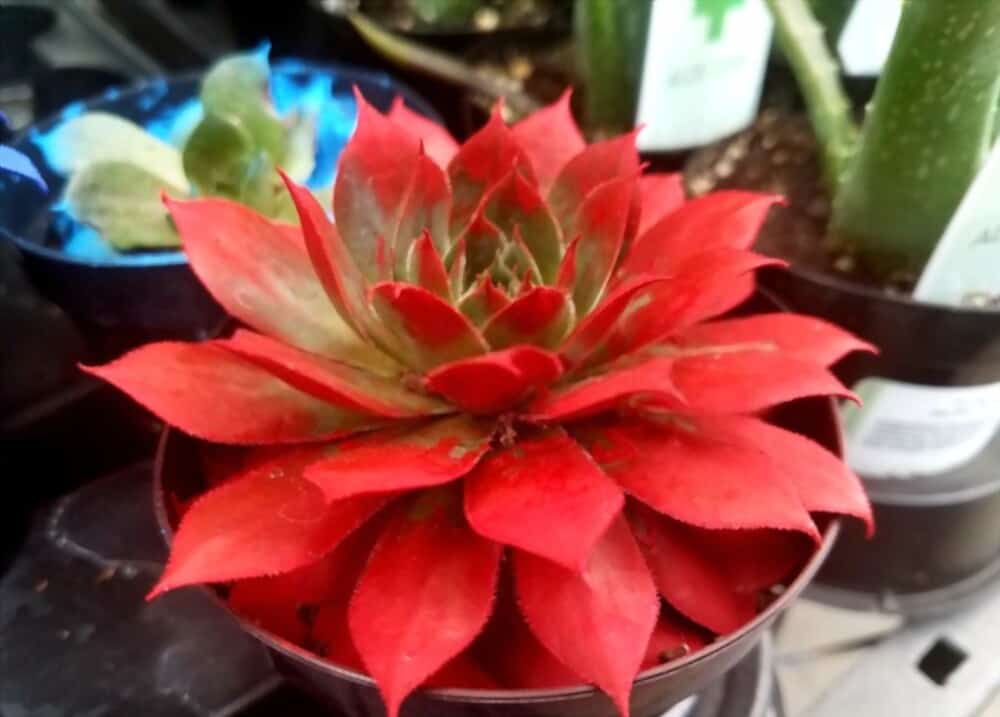
Once the proper soil is provided, succulents are incredibly intriguing plants that flourish with minimal water and care. Kosmik KaKtus, also known as Cosmic Cactus, takes the succulent’s beauty a step further by painting or dying the plant in vibrant hues.
Succulents called KosmiK Kaktus are either painted or dyed in vibrant colors to increase their beauty and allure. Echeveria, haworthia, and thimble cactus family succulents are frequently painted with acrylic paint before being sold for their aesthetic appeal and low maintenance requirements.
Succulents, like all other plants, rely on sunlight to produce food through a process called photosynthesis, and painting them can have a disastrous impact on their overall health.
In this article, we’ll provide you advice on how to safely remove the paint and give these painted succulents the attention they need.
I use this inexpensive succulent fertilizer that I discovered on Amazon for all of my succulent plants. They are kept healthy without having to speculate. Clicking here will take you there.
Table of Contents
How to take Care of a Kosmic Kaktus?

Frankly, there is no proper way to take care of a plant that was once healthy then sprayed or dipped in paint.
These painted succulents don’t require repotting as frequently as most cacti do because they do well in nutrient-poor soil and crowded situations.
These plants require the same routine of maintenance as any other succulent. They should be kept in a well-lit area and misted with water once a week when the soil feels dry.
They don’t need to be pruned, can take care of themselves to some extent, and only need watering around once a week.
Sometimes glue is used to glaze kosmik Kaktus, and then glitter is added to give the plant a glittery appearance.
By attaching imitation flowers to the crowns of some Parodia Magnifica, Mammillaria plumosa cactus, kosmik Kaktus are made.
Yes, these are aesthetically pleasing, and to the untrained sight, one may mistakenly believe that they represent some innate beauty of nature when they don’t.
When I first saw a beautifully dressed cactus with flowers and all, I was almost taken aback.Â
Thankfully, I saw paint spots of the same color on the side of the plant pot as I picked the plant up to take a closer look. It was phony!
I dropped it right away out of disgust. Then I began to wonder about what had happened.
How Long will a Kosmic Kaktus Live?

Succulents and cacti are tough plants that can endure the hardest conditions.
The plant will live for a very long period before it begins to exhibit symptoms of stress or illness, even if it is covered in paint.
Interested in the succulent’s photosynthetic process? Well, generally, plants use their leaves to do photosynthesis, absorbing light and carbon dioxide through their stomata.
Succulents, however, go about this procedure a little bit differently. They have modified leaves that bear prickly spines.
When there is little water loss due to evaporation and heat, the stomata only open at night to absorb carbon dioxide.
After taking in carbon dioxide, which is then held until daylight, the stomata close.
Then, as the plant absorbs the sunshine during the day, photosynthesis takes place.
Most of the time, the plant’s base and prickly needles are not completely covered in paint, allowing it to continue producing some food.
The plant will initially grow stunted and eventually die unless the paint is removed because the plant’s limited photosynthesis cannot support it for the duration of its existence.
How to Remove the Paint from a Succulent?
Succulents are painted with acrylic paint by dipping them in the solution while they are upside down.Â
With addition to dipping, water-based paints are also sprayed on succulents, and occasionally they are even covered in glitter to create a glittering appearance.
If no action is taken to remove the paint, it will remain strong on the plant for a long period.
But fear not, they can be easily removed utilizing the following techniques for various paint bases.
Removing Water Based Paint from Leaves
Simple steps to remove water-based paint from plants include soaking a cloth in water and washing the leaves until all traces of the paint are gone. You can use a cue tip instead of a clean cloth if you don’t have one.
Steps –
- Put a clean rag or cloth in some fresh, warm water.
- Wring the towel to get rid of the extra water.
- Use a single-directional swipe to gently rub the paint off the leaf’s surface.
- Continue until all of the paint has been taken off the leaves.
Removing Oil Based Paint from Leaves
Organic solvents are necessary to completely remove oil-based paint off succulents. Rubbish alcohol is the least corrosive organic solvent you may use.
It only dismantles the links holding the paint together, liberating it from whatever it was bound to. After that, the paint can be removed with a solitary one-directional stroke.
The removal procedures are comparable to those for water-based paint.
- Place rubbing alcohol in a clean cloth or rag to soak.
- Squeeze the cloth to remove the extra alcohol.
- Use a single-directional swipe to gently rub the paint off the leaf’s surface.
- Continue until all of the paint has been taken off the leaves.
Reminder: Never remove paint from plants with gasoline, kerosene, paint thinners, or nail polish remover.
Check out our article on how to clean paint off of plant leaves.
How are Desert Gem Cacti Colored?
Desert jewel cactus are regular cacti plants that have been artificially colored-modified.
These plants don’t have the same coloring as kosmik kaktus.
These plants aren’t painted; rather, they are colored with vibrant water-based colors.Â
You can discover that the plant eventually starts to produce new growth with a white appearance.
If the plant had not been colored, it genuinely would have that white aspect.
Although the dye improves the plant’s appearance to humans, it has no positive effects on the plant itself.
A move to Save these Painted Succulents
We advise you to stop buying these painted cacti. The only way to reduce output is through it.
It will if sales decline. These companies are making money by continuing to paint over these exquisite works of art. Â
For the time being, we can spread awareness of the issue in the hopes of reducing production.
FAQ
How do you care for a succulent cactus indoors?
Succulents enjoy having their roots kept wet, but they also dry out quickly. The soil was then irrigated once more after drying up for a few days. Succulents can be kept alive for a while by lightly misting them with water, but if you want them to flourish, you must use the “soak and dry” technique.
Can painted succulents survive?
Succulents are among the most resilient plant species, however painting them with dye will eventually destroy them.
How much sun does a succulent wall need?
Most of our common succulents require all day sun to avoid becoming leggy and not blooming. Ideally, plants in shade should receive at least six hours a day of dappled light. The benefit of low light is that plants that cannot withstand intense sunshine can rest during the warmest portion of the day.
How do you care for a KosmiK Kaktus?
These plants require the same routine of maintenance as any other succulent. They should be kept in a well-lit area and misted with water once a week when the soil feels dry. They don’t need to be pruned, can take care of themselves to some extent, and only need watering around once a week.
How do you take care of a desert gem cactus?
– Only occasionally water Desert Gems cactus. If they are grown in low light or persistently cool temperatures, they may require watering as little as once every 10 to 14 days, or even less. A lot of moisture is the quickest way to kill these vibrant cacti, so take care not to overwater them.
